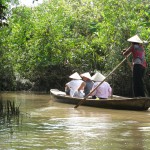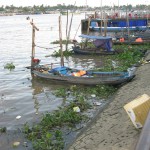Like all great rivers of the world, the Mekong disappears into the sea in a large region SW of Saigon. The Vietnamese call it the Nine Dragons, because it actually breaks up into nine major waterways as well as myriad back channels and bayous as befits a delta.

At the delta, we spent the shortest time on the water among our Mekong journeys – just three or four hours. Till now, the river seemed so full of life and so relatively undisturbed. It’s not quite the same picture here. (To read the previous posts about the Mekong, click any of the following: PART 1, PART 2, PART 3)
Village life does continue as it has for centuries, albeit with more modern power for the boats. The waterway is the main transport method to get the goods around the delta and then from that very fertile area to the cities. On the river itself, the activity throbs around you.

Go down the narrow channels, and you’ve stepped back a century, though one updated to motorcycles not bicycles or feet. But it is very placid to take a narrow channel boat powered only by a local, rowing with two long oars from a standing position. And you still find small family-owned factories that make surprising quantities of the ubiquitous rice noodles, rice wine, rice paper for spring rolls and Asian tortillas, or even puffed rice cakes laced with peanut and caramel (the rice pops like popcorn).

But the river is broken in more than 9 passageways. Sadly, here we witnessed a broader, but more diminished and spoiled Mekong, a warning sign to all the 6 countries through which it flows.
Lining the vast expanse of the river now are complete villages, commercial shops, from food-based operations to more large scale shipping and fabricating operations. Most boats are motorized and they’re big diesel powered barges, not just putt-putting fishing boats. Garbage from Saigon and other cities litter the banks as well. Also, on the surface, clumps of floating hyacinth plants that thrive on dirtier water threaten to choke off passages and oxygen. Beneath the surface, meanwhile, unseen pollutants from farming and industrial chemicals upstream kill the life in the water.

The natural fish population is disappearing due to all these effects as well as years of overfishing for a fast-growing population and export markets. Most of the fish are grown in fish farms now, though on this same waterway.
And it’s a downward cycle exacerbated by trying to control the river and watershed so that cropland can produce rice four times a year rather than two. While the more extensive use of water for irrigation has produced more food, the practice has both depleted the soil’s long-term fertility and required further use of fertilizers and pesticides, all flowing into the river. Deforestaion upriver has also led to more run-off and climate change has added to the stress by intensifying the highs and lows of the floods. It was bad here, not just in Thailand.

Modernity even threatens the ancient lifestyles, those the tourists long to see. Near Can Tho, in the lower part of the delta, the river bustles with the floating market. That is a wholesale marketplace completely on water, where barge boats filled with fruits or vegetables deliver baskets of goods to smaller vessels that maneuver back and forth as if visiting different stalls in a land-based market. In the past, these mid-river markets were the most efficient since the flooding Mekong made land operations iffy, plus only ferries crossed the dragon rivers. In the last decade, a host of bridges have spanned the waterways, including the large Calatrava knockoff at Can Tho, plus trucks are common and feeder roads extensive. So this fascinating way of life will pass as well.

Still there is hope. Five years ago trash clogged the feeder river in Saigon. Since the government stepped in, the river has been cleaned of debris and filtration has stopped much of the nasty effluent. It’s not perfect yet, but it has made a major improvement already. Upriver the government is helping to replant forests cleared for agriculture. At the delta itself, they’ve limited the numbers of boats that can participate in the market in hopes of controlling the supply and the pollution. But, as our guide stressed, the attitude of the local village people must change before real progress can be made. Unfortunately he thinks this will take another generation so he prays that will not be too late.
(For more pictures from Vietnam, CLICK HERE to see the slideshow at the end of the Vietnam itinerary page.)


I think my favorite photo so far from Nam is the motorcycle with the “story” boxes or the smoking incense one. Pop-up hole pretty funny. Question, did you or did you not fire AK-47 at cafe. And why is there no photo of this.
The ability of the cycle-truckers to carry goods is one of the marvels of the world. This one had weight and bulk, but we’ve seen many with an array of lighter goods bulging out and up so the cargo virtually envelops the driver. And there is virtually nothing they won’t try to carry. But this driver knew he was good, so he gave us a thumbs up before he motored off.
Re the incense at temple, notice that the cones hanging down are also burning incense sticks burning. As for AK-47, since in the past I was trying to stay out of Vietnam so that I wouldn’t be the target for one of these, I decided to demur. Some things deserve other than a photo.